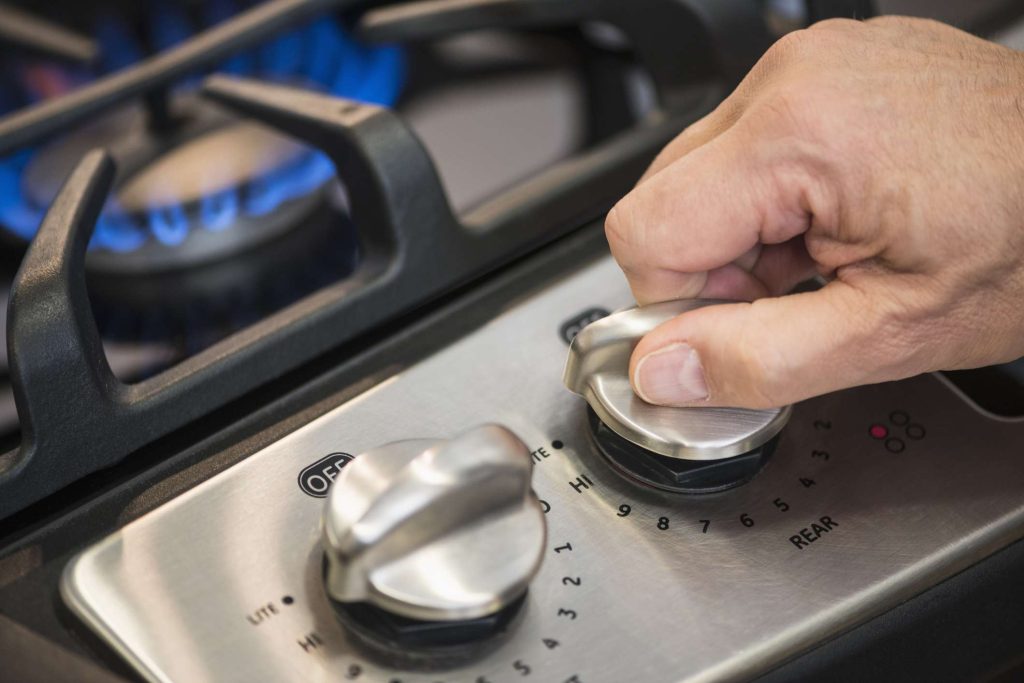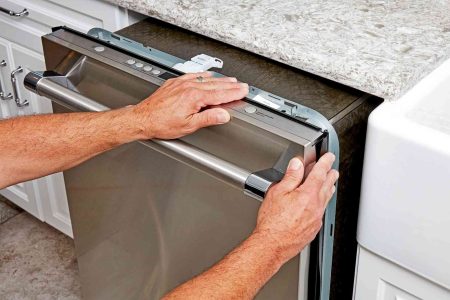To choose the right type of stove for your kitchen, combine a stove style that you like—induction, radiant, freestanding, and more—with the kitchen’s fuel type, whether electric or gas. This guide breaks down the seven basic types of stoves and whether they are gas or electric, along with how to choose the best type of stove for your kitchen.
Induction Stove
An induction range is an electric stove that cooks by heating up the cookware with a strong magnetic field. You can also buy induction cooktops.
The top of an induction stove is protected by ceramic glass. Hidden below the glass are elements that cause ferromagnetic pots and pans to heat up, thus cooking the food inside.
It’s easy to clean an induction stove because of the smooth, cool top. Most spills can be cleaned with sponges. Clean an induction stove with a ceramic glass top cleaning product.
Being limited to certain types of cookware can be a consideration for some buyers. The cookware must be cast iron, enameled cast iron, a type of stainless steel, or a metal pan adapter can be used. Aluminum and glass cookware will work only with the slip-in adapter.
Also, an induction stove is induction-style only with the burners. The oven is still a conventional, electrically powered convection oven.
Tip
A stove is a single unified cooking device, either gas or electric, that has both burners on top and an oven on the bottom. A cooktop is a gas or electric open flat surface that is installed within the kitchen countertop. Though a cooktop has no oven, one can be added to the kitchen separately with a wall oven.
Radiant Stove
A radiant stove is an electric stove with burners under a smooth ceramic glass top.
A radiant stove and an induction stove look similar, with the heating source hidden below a smooth ceramic-glass top. With radiant stoves, though, coils radiate heat (not magnetic energy) upward through the glass.
When cool, a radiant stove glass top is easy to clean with a sponge or with paper towels. Because the surface gets extremely hot, food remains can bake onto the surface. The surface can be cleaned with a ceramic glass top cleaning product or scraped with a razor.
Radiant stovetops stay hot for a long time after the heat has been turned off. Hot surface indicators remain lit until the surface temperature drops below a certain point, like 150°F or 125°F.
What Is a Bridge Element Burner?
A bridge burner connects two round heating elements to form one larger oval-shaped element to create a larger cooking space. This optional feature is found on some radiant and induction stoves.
Electric Stove
An electric stove heats the cookware by direct contact between exposed heated coils and the cookware. An electric stove is a single appliance with burners on top and a convection oven on the bottom.
Electric stoves with exposed coils tend to be very durable since they have no glass top that can break or scratch. The exposed coils can easily be pulled out for cleaning. If a coil fails, it can be removed and replaced.
This type of stove is more difficult to clean than smooth glass top stoves because food can clog the coil or the drip pans.
Freestanding Stove
A freestanding stove has burners on top and an oven on the bottom. Induction, radiant, electric, and gas stoves can all be freestanding stoves.
One feature that distinguishes a freestanding stove from a slide-in stove is the raised panel on the back. The panel has burner controls and also acts as a backguard. Some freestanding stoves separate the controls, with some controls in the back and some in the front.
True to its name, a freestanding stove can stand free of surrounding cabinets on one or even both sides, since the sides are finished.
Slide In Stove
A slide in stove has burners on top and a convection oven on the bottom. Induction, radiant, electric, and gas stoves can be slide in stoves.
A slide in stove differs from a freestanding stove in that it has no back panel. The back of the stove rests against a backsplash installed on the wall.
With the controls located on the front, plus the lack of a back panel, a slide in stove sleekly fits in between two kitchen base cabinets. Because a slide in stove’s sides are unfinished, the stove must have cabinets on both sides.
The lack of a back panel also means that the slide in stove can be installed in a kitchen island.
Commercial Style Stove
A commercial style stove is much like a restaurant stove, both in form and in function.
A commercial style stove has higher burner grates, a greater flame capacity, grates that run across the top, and special features like griddles.
Like a slide in stove, a commercial style stove has no backsplash. Matching backsplashes are usually available to purchase separately or you can install your own backsplash.
This type of stove is nearly always gas. It comes in widths from the standard 30-inch width up to a double-size 60-inch width.
Downdraft Stove
A downdraft stove has burners on top, an oven on the bottom, and a ventilation system that eliminates the need for an exhaust fan and hood. The downdraft system pulls cooking odors, steam, and smoke down through a ventilation tube that exits the side or top of the house.
A downdraft stove can be either gas or electric. The downdraft feature can be paired with an electric stove, freestanding stove, slide in stove, or commercial stove.
The downdraft ventilation fan may either be flush against the cooktop surface or in the form of a retractable unit that electrically raises and lowers.
How to Choose a Stove
To choose the best stove for your kitchen, first decide which fuel source you want to use, whether gas or electric. Next, find a stove style in that fuel category. Finally, find a stove with the size and design that works in the kitchen layout.
Stove Fuel Source
A stove is powered either by electricity or by gas, usually natural gas. Do you want to keep the existing fuel source or switch to a new one? The fuel source may determine the type of stove.
-
Induction stove
-
Electric (coil) stove
-
Radiant stove
-
Freestanding stove
-
Slide in stove
-
Downdraft stove
-
Freestanding stove
-
Slide in stove
-
Downdraft stove
-
Commercial-style stove
If your home has gas, for example, you cannot install an induction stove. You’ll need to hire an electrician to install 240V electricity to that area.
If you want a gas stove but no gas line, this requires permitting and installation by a plumber certified to work with gas.
Gas Stove
- Heats up quickly
- Temperature changes fast
- Highly energy inefficient
- Indoor air pollutants
Electric Stove
- Energy efficient
- Clean burning
- Heats up slowly
- Slow temperature changes
Stove Style
Choose the type of stove that pairs best with your kitchen and your style of cooking:
- Induction stove: Best for stovetop safety and for energy savings, though cookware choice is limited
- Electric stove: Save on the cost of the stove by keeping it simple with an exposed coil electric stove
- Radiant stove: Like the electric stove, but with a ceramic glass top protecting the electric coils
- Freestanding stove: A basic type of stove that comes with a rear control panel and finished sides for layout flexibility
- Slide in stove: For a low, sleek look that merges well with countertops and cabinets
- Commercial-style stove: Best for serious cooks who need more space and the sensitive temperature control that gas brings
- Downdraft stove: When you need exhausting but don’t have or don’t want a traditional hood-style exhaust fan
Stove Size and Design
Most stoves are 30 inches wide. This versatile stove width fits in nearly every kitchen layout, even down to space-starved one-wall or galley kitchen layouts. Other widths are 36 inches, 48 inches, and 60 inches.
Consider the sides of the stove. Will the stove be located at the end of a bank of base cabinets? If so, you’ll need a freestanding stove. Slide-in stoves have unfinished sides, so they need to be installed within base cabinets or in a kitchen island.
Stove Costs
Electric stoves are the least expensive type of stove, starting at around $500. To upgrade to a radiant-style electric stove, costs start at around $600 and range up to $3,300.
Upper-end induction stoves come with commensurate upper-end prices: $2,500 to $5,600 and even higher. Induction stoves use very little power, so the cost savings helps to offset the higher purchase price.
| Stove | Cost |
| Induction stove | $2,500 to $5,600 |
| Electric stove | $500 to $2,300 |
| Radiant stove | $600 to $3,300 |
| Freestanding stove | $500 to $2,700 |
| Slide in stove | $1,600 to $3,600 |
| Commercial style stove | $4,200 to $12,000 |
| Downdraft stove | $3,200 to $3,600 |
Read the full article here














